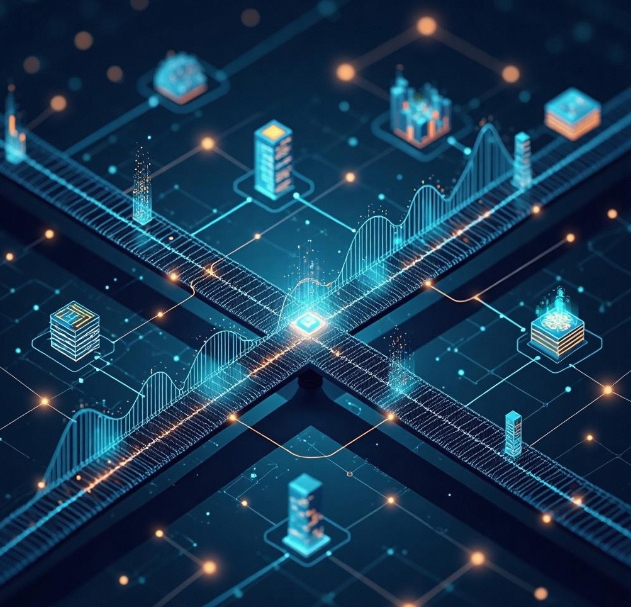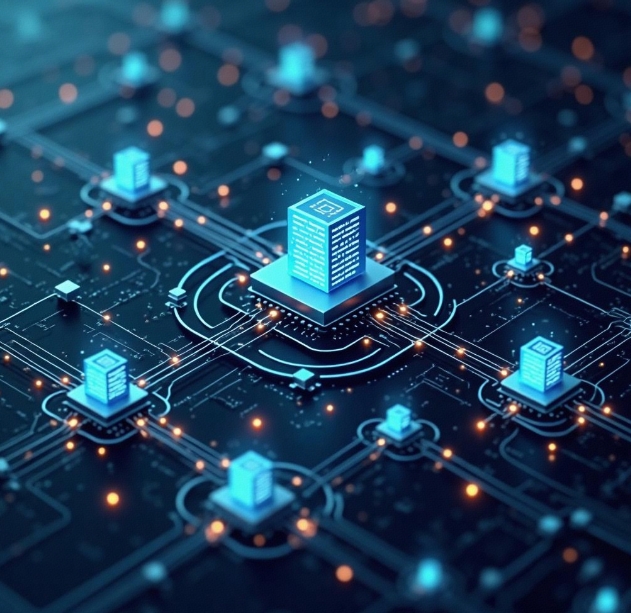Future Trends in DApp Development: Integration of Cross-Chain, AI, and Decentralized Computing
- latest articles
- 1.DApp Development & Customization: Merging Diverse Market Needs with User Experience 2.Analysis of the Core Technical System in DApp Project Development 3.How to achieve cross-chain interoperability in Web3 projects? 4.How does the tokenization of points reconstruct the e-commerce ecosystem? 5.How to Set and Track Data Metrics for a Points Mall? 6.What is DApp Development? Core Concepts and Technical Analysis 7.Inventory of commonly used Web3 development tools and usage tips 8.Development of a Distribution System Integrated with Social E-commerce 9.Six Key Steps for Businesses to Build a Points Mall System 10.What is DApp Development? A Comprehensive Guide from Concept to Implementation
- Popular Articles
- 1.Future Trends and Technology Predictions for APP Development in 2025 2.Analysis of the DeFi Ecosystem: How Developers Can Participate in Decentralized Finance Innovation 3.From Zero to One: How PI Mall Revolutionizes the Traditional E-commerce Model 4.DAPP Development | Best Practices for Professional Customization and Rapid Launch 5.Recommended by the Web3 developer community: the most noteworthy forums and resources 6.From Cloud Computing to Computing Power Leasing: Building a Flexible and Scalable Computing Resource Platform 7.How to Develop a Successful Douyin Mini Program: Technical Architecture and Best Practices 8.Shared Bike System APP: The Convenient Choice in the Era of Smart Travel 9.How to Create a Successful Dating App: From Needs Analysis to User Experience Design 10.From Design to Development: The Complete Process of Bringing an APP Idea to Life
With the continuous advancement and expanding applications of blockchain technology, the development of decentralized applications (DApps) is encountering unprecedented opportunities and challenges. DApps are no longer limited to digital currencies and the financial sector; their application scenarios now encompass gaming, social networking, supply chains, governance, and many other fields. As technology continues to evolve, the future trends of DApps are becoming increasingly clear. The integration of cross-chain technology, artificial intelligence (AI), and decentralized computing will become key drivers for the development of DApps.
This article will explore how cross-chain technology, AI, and decentralized computing will integrate in future DApp development and examine their impact on the blockchain ecosystem and user experience.
I. Cross-Chain Technology: Breaking the "Island" Limitations of Blockchain
Since its inception, blockchain technology has faced a problem—the "island effect" of blockchains. Currently, mainstream blockchain systems such as Bitcoin, Ethereum, and EOS, while each having powerful application scenarios and supported functionalities, cannot directly interact with each other in terms of data and assets. This "island effect" limits the further development of blockchain technology and hinders synergy between different blockchains.
Cross-chain technology has emerged to address this issue. It enables interoperability and collaboration between different blockchains, allowing assets to flow freely across chains and data to be shared cross-chain, thereby breaking down the barriers between blockchain "islands" and building a more open and interconnected blockchain ecosystem.
In the context of DApp development, cross-chain technology has a wide range of application scenarios. For example, it can enable a DApp to run on multiple blockchain platforms, leveraging the advantageous features of different blockchains. For instance, Ethereum's smart contract functionality and Bitcoin's security can be combined through cross-chain technology, allowing DApps to achieve better functionality and performance optimization across different chains.
Additionally, cross-chain technology can promote the development of decentralized finance (DeFi) applications. Currently, many DeFi projects are based on single platforms like Ethereum. The introduction of cross-chain technology can enable DeFi projects to support asset exchanges and liquidity pools across multiple chains, further enhancing the scalability and user experience of DeFi applications. For example, projects like Cosmos and Polkadot are dedicated to achieving interoperability of multi-chain assets through cross-chain protocols.
II. The Integration of AI and DApp Development: The Perfect Fusion of Intelligence and Decentralization
Artificial intelligence (AI), as one of the most cutting-edge technologies today, is gradually transforming various industries. AI provides strong support in areas such as data analysis, pattern recognition, and decision optimization. Decentralized applications (DApps), as part of blockchain technology, possess characteristics like decentralization, immutability, and transparency. The combination of these two fields holds immense potential.
AI Applications in Smart Contracts
Smart contracts are a crucial component of blockchain technology, enabling automated and decentralized contract execution. However, traditional smart contracts typically execute only according to predefined rules and lack the ability for intelligent judgment and learning. The introduction of AI can make smart contracts more flexible and intelligent.
For example, through machine learning algorithms, smart contracts can adjust their execution logic based on real-time data changes, achieving more intelligent automated decision-making. In the financial sector, AI can help DApps predict trends based on market data and user behavior, automatically executing smart contracts for more precise trading decisions. For instance, AI can analyze historical data to predict price fluctuations of an asset and automatically adjust the conditions of the smart contract based on the predictions to maximize user benefits.
AI-Driven Decentralized Applications
The decentralized nature of DApps allows them to break free from the constraints of traditional centralized applications, but this does not mean they do not require intelligent support. AI can assist in various aspects of DApps, such as data analysis, personalized recommendations, and automated decision-making, further enhancing the user experience.
For example, in the decentralized finance (DeFi) space, AI can predict market trends to help users make more informed investment decisions. In decentralized social platforms, AI can analyze user interests and behaviors to provide personalized content recommendations. In decentralized supply chain management, AI can help predict changes in demand for goods and optimize inventory management, thereby improving the efficiency and transparency of the supply chain.
III. Decentralized Computing: Providing Powerful Computational Support for DApps
Decentralized computing refers to the use of distributed computing resources for task processing, rather than relying on traditional centralized servers. This concept aligns closely with the decentralized nature of blockchain, making it a topic of widespread interest in blockchain applications.
In DApp development, decentralized computing can provide powerful computational capabilities, especially in scenarios requiring substantial computing resources. For example, in areas such as decentralized data storage, data analysis, and AI training, decentralized computing can fully leverage its advantages to offer flexible, efficient, and decentralized computing services.
The Integration of Decentralized Computing and DApps
Decentralized computing can provide DApps with more computational resources and greater scalability. Traditional DApps often rely on a single blockchain node for computation and data storage, which limits their performance and scalability. The introduction of decentralized computing enables DApps to mobilize distributed computing resources globally, achieving more efficient computation and data processing.
For example, in the decentralized finance (DeFi) space, decentralized computing can be used for compute-intensive tasks such as high-frequency trading and market analysis. In decentralized social platforms, it can handle tasks like real-time video processing and data encryption, enhancing platform performance and user experience.
Challenges and Solutions in Decentralized Computing
Although decentralized computing offers many advantages for DApps, it also faces challenges. First, the widespread distribution of computing resources may lead to unstable computational efficiency. Second, decentralized computing often requires more technical support and infrastructure development, such as distributed storage and data encryption.
To address these issues, many decentralized computing platforms are continuously evolving. For example, decentralized storage platforms like Filecoin and Storj already provide reliable decentralized data storage and computing services. At the same time, the ongoing improvement of blockchain technology itself offers stronger support for the realization of decentralized computing.
IV. Future Prospects of the Integration of Cross-Chain, AI, and Decentralized Computing
In the future, as technology continues to advance, the integration of cross-chain technology, AI, and decentralized computing will become a mainstream trend in DApp development. The combination of these three elements will not only enhance the performance and functionality of DApps but also create a more intelligent and efficient blockchain ecosystem.
The Combination of Cross-Chain and AI
Through cross-chain technology, data and assets can flow freely between different blockchains, while AI can perform real-time analysis and optimization of cross-chain transactions, improving the efficiency and security of asset flows. The combination of cross-chain and AI can bring a more intelligent and efficient trading experience to areas such as decentralized finance and decentralized markets.
The Combination of Cross-Chain and Decentralized Computing
Cross-chain technology can break down barriers between different blockchains, while decentralized computing provides powerful computational support. When combined, DApps can distribute and schedule computational tasks across multiple chains, achieving more efficient computation and resource utilization. For example, in decentralized AI training, cross-chain technology can enable computational resources from different blockchains to participate collectively, while decentralized computing provides the necessary processing power.
The Combination of AI and Decentralized Computing
The combination of AI and decentralized computing will provide DApps with more intelligent and efficient computational resources. AI can play a role in decentralized computing networks, optimizing the allocation and execution of computational tasks. Decentralized computing, in turn, offers powerful computational support for AI, enabling more efficient data processing and learning in a decentralized environment.
V. Conclusion
The future of DApps will be a fusion of cross-chain technology, AI, and decentralized computing. As these technologies continue to develop and mature, DApps will enter a new era of greater intelligence, efficiency, and scalability. Cross-chain technology will break the island limitations of blockchains, AI will provide intelligent decision-making support for DApps, and decentralized computing will offer powerful computational capabilities. The integration of these three elements will drive the rapid development of decentralized applications and bring users richer experiences and services.
In the future, we have every reason to believe that DApps will not only be decentralized applications but also an intelligent, open, and interconnected blockchain ecosystem.
-

DApp Development & Customization: Merging Diverse Market Needs with User Experience
As blockchain technology matures and becomes more widespread, decentralized appl···
-

Analysis of the Core Technical System in DApp Project Development
With the rapid development of blockchain technology, decentralized applications ···
-

What is DApp Development? Core Concepts and Technical Analysis
With the rapid development of blockchain technology, decentralized applications ···

 Blockchain
Blockchain












